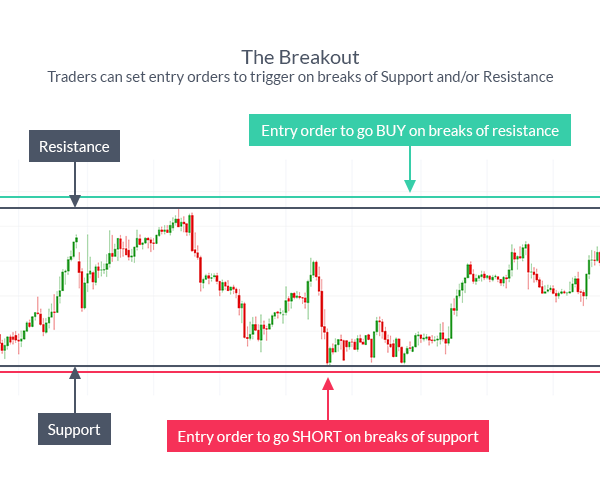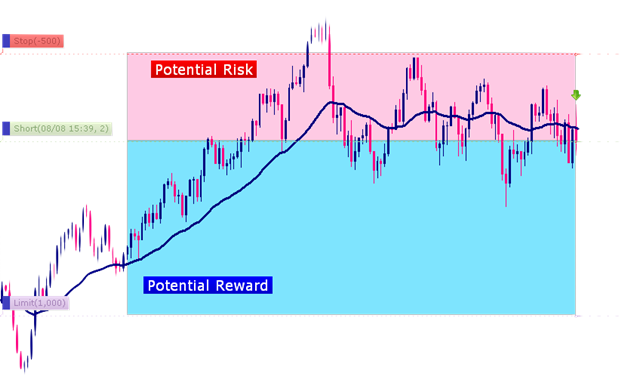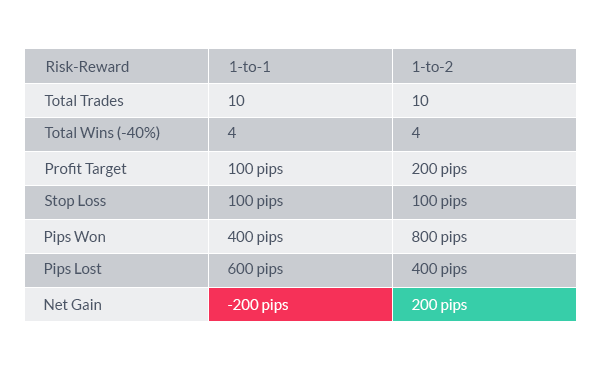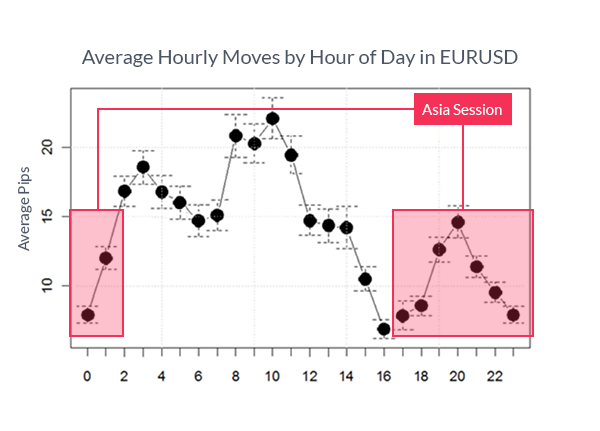Of the three primary market conditions that traders can focus upon, the most difficult to learn is often the breakout.
Trading breakouts involves looking to enter trades with breaks of support and resistance levels. If it’s a resistance level getting broken, breakout traders want to look to go long. If it’s support, traders want to look to go short. The following picture will illustrate this setup directly on the chart:

The idea is that support/resistance can serve as an impediment to future price movements. When these levels get broken, that impediment is thought to no longer exist; and traders look to take price higher with long trades or price lower with short trades.
Unfortunately, learning to trade breakouts may not be so simple.
The reason for this is because the very thing that makes breakouts attractive, volatility, also makes them dangerous. In this article, we are going to address the topics of breakouts, and maybe more importantly – how traders can customize their approaches for trading in these attractive, yet potentially treacherous conditions.
Looking for VolatilityWhen planning to trade volatility, it can help greatly to visualize the environment in which we are looking to take part in.
Breakouts emanate from ranges. Ranges will often populate when traders are unsure of the future direction of prices. A good example of this phenomenon is a major news release or economic data announcement; when FX traders can regularly witness range-bound prices going into a release.
We looked at this very topic in the article Attacking News Events with Price Action, in which we go in-depth behind a news trading strategy built on this very premise. The picture below, taken directly from the article, will show how the strategy could have been implemented leading into the Non-Farm Payrolls report in May of this year.

Just as we can see in the above graphic, support became broken as the news began circulating in the environment. The news release brought additional volatility into the market, and this created the break of support that breakout traders are looking to take advantage of.
Breakouts will often be triggered by increases in volatility that creates breaks of support and/or resistance levels. But just as we had said earlier, this can be dangerous – which is why breakouts often need strong risk management parameters to be effective over the long-term.
Managing volatilityWe mentioned previously that volatility can be dangerous, and the reason that it can be dangerous is because we never know how far, or how long a price movement might continue.
In some cases, support or resistance can become broken only to see price move against us – directly to our stop. This brings on the concept of the ‘false breakout,’ in which a major level is broken without price continuing to move in that direction. The picture below will illustrate a false breakout:

False breakouts can be abundant, and since we know that most breakouts will occur around volatile periods in the market (when price can move for, or against us for an extended period of time); breakout traders want to look to risk management in an effot to mitigate the damage brought upon by false breakouts. This is where stop-loss orders and strong risk management can help.
The Risk Management of BreakoutsAs mentioned on the chart above, false breakouts are the nemesis of the breakout trader. This is because false breakouts can move against the trader’s position for an extended period of time, potentially wiping away the gains of many successful trades.
Because of the increased volatility of trading breakouts, the necessity of proper risk management is at its upmost of importance. Traders using poor risk management face very large and very realistic risks of losing much more than they anticipate when trading these volatile market conditions.
In the DailyFX Traits of Successful Traders research series, the topic of risk management was at the forefront of the discussion. Not coincidentally, many consider this very topic to be what differentiates professional from amateur traders. Breakout traders can institute these principals in an effort to institute strong risk management to their breakout strategies.
In the Number One Mistake that Forex Traders Make, Quantitative Strategist David Rodriguez talks about the importance of risk-reward ratios. The summary of the article is as follows:
Traders are right more than 50% of the time, but lose more money on losing trades than they win on winning trades. Traders should use stops and limits to enforce a risk/reward ratio of 1:1 or higher.
When trading breakouts, traders should expect the possibility of false breakouts to bring lower overall winning percentages than in other strategies. But in the fewer instances that those traders do win, those winning trades could move for an extended period of time. As such, when trading breakouts, traders may want to look at more aggressive risk-reward ratios, such as 1-to-2 or greater (for every $1 risked, $2 is sought in return). The picture below will illustrate a 1-to-2 risk to reward ratio:

With a 1-to-2 risk-to-reward ratio, a trader needs to be profitable only 40% of the time to obtain a net profit. We discussed this at-length in the article, How to Build a Strategy, Part 5: Risk Management.

The topic of breakouts was discussed again in the 3rd part of the Traits of Successful Traders series, in the article Here is How to Trade Forex Majors like the Euro During Active Hours. In this article, volatility comes to the forefront of the discussion, as David Rodriguez investigated trader profitability based on time-of-day. The chart below will show the ‘average hourly move’ or the average amount of volatility on EURUSD based on the time of day:

From the chart above, we can see the Asian session leading into the London session (at 3AM ET – shown on the horizontal axis), as the average hourly move for EURUSD increases, highlighting the increased volatility.
As such, traders are often well served looking to focus their breakout strategies to this period, as volatility can increase when the London session comes online.
In the 4th part of the series, How Much Capital Should I Trade Forex With, Jeremy Wagner looks at the amount of leverage utilized by traders. The chart below will illustrate trader profitability (in blue bars) based on the amount of equity, and average effective leverage being utilized by traders:

In the research, Jeremy found that traders with larger account balances (the $9,999 group in the above chart), used far less leverage than traders with smaller account balances (the $999 group above). Traders using more moderate levels of leverage (5-to-1) saw far greater profitability (37.37% of the time), than traders using smaller account balances (20.91% of the time).
Jeremy suggests that traders look to keep leverage under 10-to-1, meaning for every $5,000 on deposit in the traders account – they are looking to trade position sizes of $50,000 or less.
Risk Management SummaryTo summarize, traders should look to address risk management through multiple accords when trading breakouts. Traders should look to trade with a favorable risk reward ratio (in which the trader is seeking more profit, than they are putting up to risk), while focusing their trading on the more volatile periods of the day, and traders should look to utilize leverage of less than 10-to-1 on breakout trades.